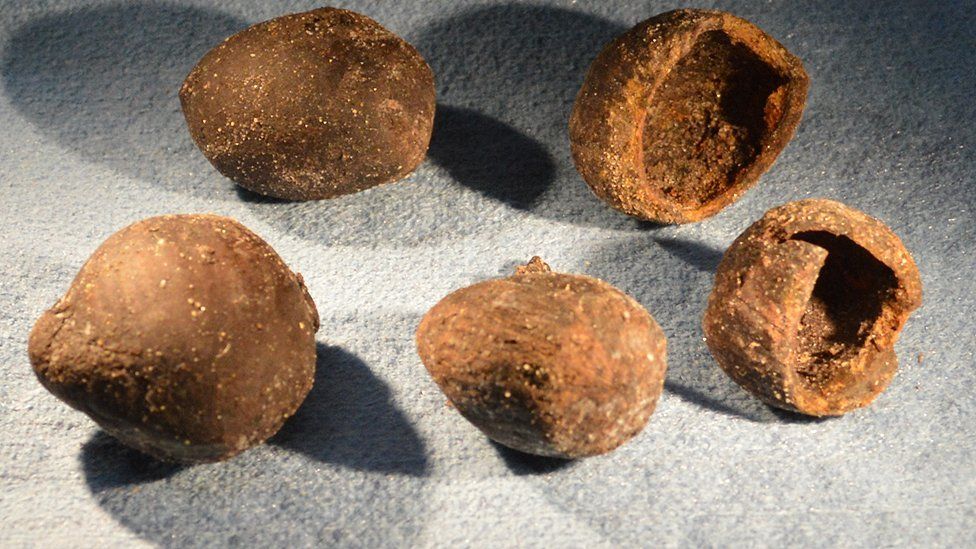Burial Site In France Dating Back To 6500 Bc
- Burial Site In France Dating Back To 6500 Bc Movie
- Burial Site In France Dating Back To 6500 Bc Years
- Burial Site In France Dating Back To 6500 Bc Today
- Burial Site In France Dating Back To 6500 Bc Timeline
A skull that's more than three and a half millennia old has revealed signs of an early form of brain surgery.
The first monolith structure in Europe was found in Brittany dating back as far as 4,794 BC and other early monuments (red) were found in northwest France, the Channel Islands, Catalonia, southwestern France, Corsica, and Sardinia from a similar time period. The oldest samples of skulls with bore holes drilled into them were found in a burial site in France dating back to 6500 BC.
The perforated skull belongs to a mummified woman found in the Xiaohe tomb in China's Xinjiang Uygur Autonomous Region.
(Carbon dating performed in the year of 2008.) 2250 The Mycenae Greeks are in contact with sea-going tradesmen, the Minoans of Crete – a commercial society ruled by the wealthy. 2200 Troy, a coastal town in Asia Minor, known as Troy II among archaeologists (a second level settlement with numerous others to be built on top in coming centuries. According to paleolithic scholar Jean Clottes, they are very similar to the 'chimney' signs found in the Pech-Merle cave paintings (Lot, France), whose art dates back as far as 25,000 BCE. In other words, the cave painting at Lascaux is most likely to date back to about 15,000-17,000 BCE, with the earliest art being created no later than 17,000. The second oldest proof of the use of acorns as food in Europe is found in late Paleolithic Magdalenian sites of northern Iberia. The Magdalenian culture is one of the later cultures of the Upper Paleolithic in western Europe, dating from around 15,000 to 10,000 BC whose remains are found in France and Spain.
Experts said that the hole, which measures around 2 inches (50mm) in diameter, was most likely an early form of craniotomy.
The perforated skull (pictured) was discovered as part of a mummified body of a woman in the 'Little River' Xiaohe tomb complex. Experts said that the hole, measuring around 2 inches (50mm) in diameter, was most likely an early form of craniotomy - a procedure that involves removing bone to get access to the brain
A craniotomy involves temporarily removing a 'flap' of bone from the skull to give surgeons access to the brain.
Share this article
The amount of skull removed depends on the type of surgery being performed, and the flap is later replaced using screws.
It may have also been a form of trepanation, which involves the removal of a piece of bone from the skull.
This procedure has been performed since prehistoric times, and cave paintings indicate that ancient people believed the practice would cure epileptic seizures, headaches and mental disorders.
The wound suggests that the female (pictured), who died in her 40s, must have lived for at least a month, or even longer, after receiving the surgery
Lead archaeologist Zhu Hong who made the discovery said: '[The wound] suggests the female, who died in her 40s, must have lived for at least a month, or even longer, after receiving the surgery.'
He added there were also signs of healing tissues around the wound.
The mummy dates back to 1,615 BC and is one of hundreds discovered in the Xiaohe 'Little River' Tomb complex.
Lying 108 miles (175 km) west of the ancient city of Loulan, the site was first explored in 1934 by Swedish archaeologist Folke Bergman, but not fully excavated until 2005.


Dating of the area has shown it goes back to approximately 2,000 BC, although tests have revealed the bodies contain DNA from the east and west.
In particular, males were found to have chromosomes typically found in Northern and Eastern Europe, alongside DNA found in Siberia.
The massive burial site has more than 330 graves and contains the largest number of mummies ever found in the world.
These tombs include adults and children as well as 15 intact mummies, although approximately half of the tombs were said to have been looted by grave robbers.
The majority of the coffins found on the site were made of wood, and were shaped like boats, buried upside down.
The mummy dates back to 1,615 BC and is one of hundreds discovered in the Xiaohe 'Little River' Tomb complex in China's Xinjiang Uygur Autonomous Region (pictured left). Lying 108 miles (175 km) west of the ancient city of Loulan, the site was first explored in 1934 by Swedish archaeologist Folke Bergman
The massive burial site has more than 330 graves and contains the largest number of mummies ever found in the world. These tombs include adults and children as well as 15 intact mummies. The majority of the coffins found on the site were made of wood, and were shaped like boats (pictured) buried upside down
WHAT IS TREPANATION?
Trepanation involves the removal of a piece of bone from the skull, and it has been performed since prehistoric times.
Cave paintings indicate that people believed the practice would cure epileptic seizures, headaches and mental disorders.
The oldest samples of skulls with bore holes drilled into them were found in a burial site in France dating back to 6500 BC.
But it was also used by the Ancient Egyptians, Chinese, Indians, Romans, Greeks and the early Mesoamerican civilizations.
Even the 'father of medicine' Hippocrates advocated the process in his 400 BC tome 'On Injuries of the Head'.
Burial Site In France Dating Back To 6500 Bc Movie
Modern exponents say it increases blood flow in the brain, increasing lucidity and heightening brain function.
This practice is similar to how the Egyptians believed boats would take Pharaohs to the land of the ‘Gods’
Clothes and jewellery found in the tomb were also buried alongside the mummies, in small baskets, and the bodies were wrapped in cowhide and wool.

This prevented sand from getting inside the corpses.
In addition to the wood coffins, four clay-covered rectangular coffins were also found, surrounded by stakes.
And six of the coffins were found to contain wooden 'bodies', rather than corpses.
Each of these wooden sculptures were the same shape and were designed to look like males.
Sexual iconography was everywhere at the site, with posts representing phalluses and vulvas placed in front of each grave.

Last week, scientists recreated ancient brain surgery to understand medical techniques that existed almost 2,500 years ago.

A team of experts in Russia spent the past year examining skulls found with intricate surgical holes in a bid to fathom out how early nomadic doctors carried out their work.
This practice is similar to how the Egyptians believed boats would take Pharaohs to the land of the ‘Gods’. Clothes and jewellery found in the tomb were also buried alongside the mummies, in small baskets, and the bodies (pictured) were wrapped in cowhide and wool. This prevented sand from getting inside the corpses
Last week, scientists recreated ancient brain surgery on a modern skull (shown) to understand medical techniques that existed almost 2,500 years ago. A team of experts in Russia spent the past year examining skulls found with intricate surgical holes in a bid to fathom out how early nomadic doctors worked
Evidence from ancient skulls (pictured) suggest they are among the earliest ever examples of trepanation - an ancient form of neurosurgery
Burial Site In France Dating Back To 6500 Bc Years
Evidence suggested they were among the earliest ever examples of trepanation - the oldest form of known neurosurgery - with the procedures skilfully carried out.
The oldest samples of skulls with bore holes drilled into them were found in a burial site in France dating back to 6500 BC.
But it was also used by the Ancient Egyptians, Chinese, Indians, Romans, Greeks and the early Mesoamerican civilisations.
Even the 'father of medicine' Hippocrates advocated the process in his 400 BC tome 'On Injuries of the Head'.
Burial Site In France Dating Back To 6500 Bc Today
The procedure was carried out by Aleksei Krivoshapkin according to ancient methods used in the Altai Mountains on the skull of a woman who had died of natural causes shortly before.
Burial Site In France Dating Back To 6500 Bc Timeline
Analysis of the skulls of ancient patients found that the operations were carried out with only one tool, a bronze knife, with the surgeons carefully scraping at the skull, yet leaving behind only minimal traces of their work.